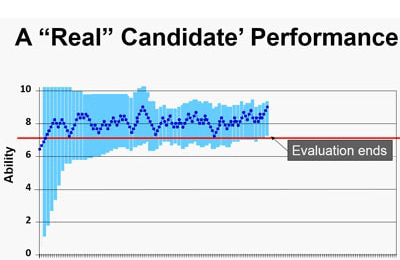
A 95% Confidence is Necessary to Pass / Fail a CAT Exam
The computer stops the exam at the minimum number of items in the following situations:
- There is a 95% confidence the candidate is at or above the passing standard.
- There is a 95% confidence the candidate is below the passing standard
- The candidate has reached the maximum allotted time
The high-jump analogy can describe the way a CAT exam works. First, the National Registry calibrates every item on a live examination to estimate its difficulty level on a standard scale. Then, the computer adaptive test learns the candidate’s ability level as they take the examination and compares their responses against that scale.
The test begins with an item that is slightly below the passing standard. The item may be from any subject area in the test plan:
- Airway, Respiration & Ventilation
- Cardiology & Resuscitation
- Trauma Medical / Obstetrics / Gynecology
- EMS Operations
After the candidate gets a short series of items correct, the computer will choose items of a higher ability, perhaps near entry-level competency. The examination selects these items from a variety of content areas of the test plan. If the candidate answers most of these questions correctly, the computer will choose new items at an even higher ability level.
Again, if the candidate answers many of these items correctly, the computer will present the candidate with more items of an even higher ability level. Eventually, every candidate will reach their maximum ability level and begin to answer items incorrectly.
Thus, the computer evaluates a candidate’s ability level in real-time. The examination ends when there is enough confidence the candidate is above or below the passing standard once the candidate responds to a minimum number of items.
SOURCE: https://www.nremt.org/document/cognitive-exams
Pass your NREMT Exam on the FIRST Attempt!
How to NREMT teaches how to master and dominate the NREMT exam. Our goal is to have you pass the NREMT exam on your very first attempt!

